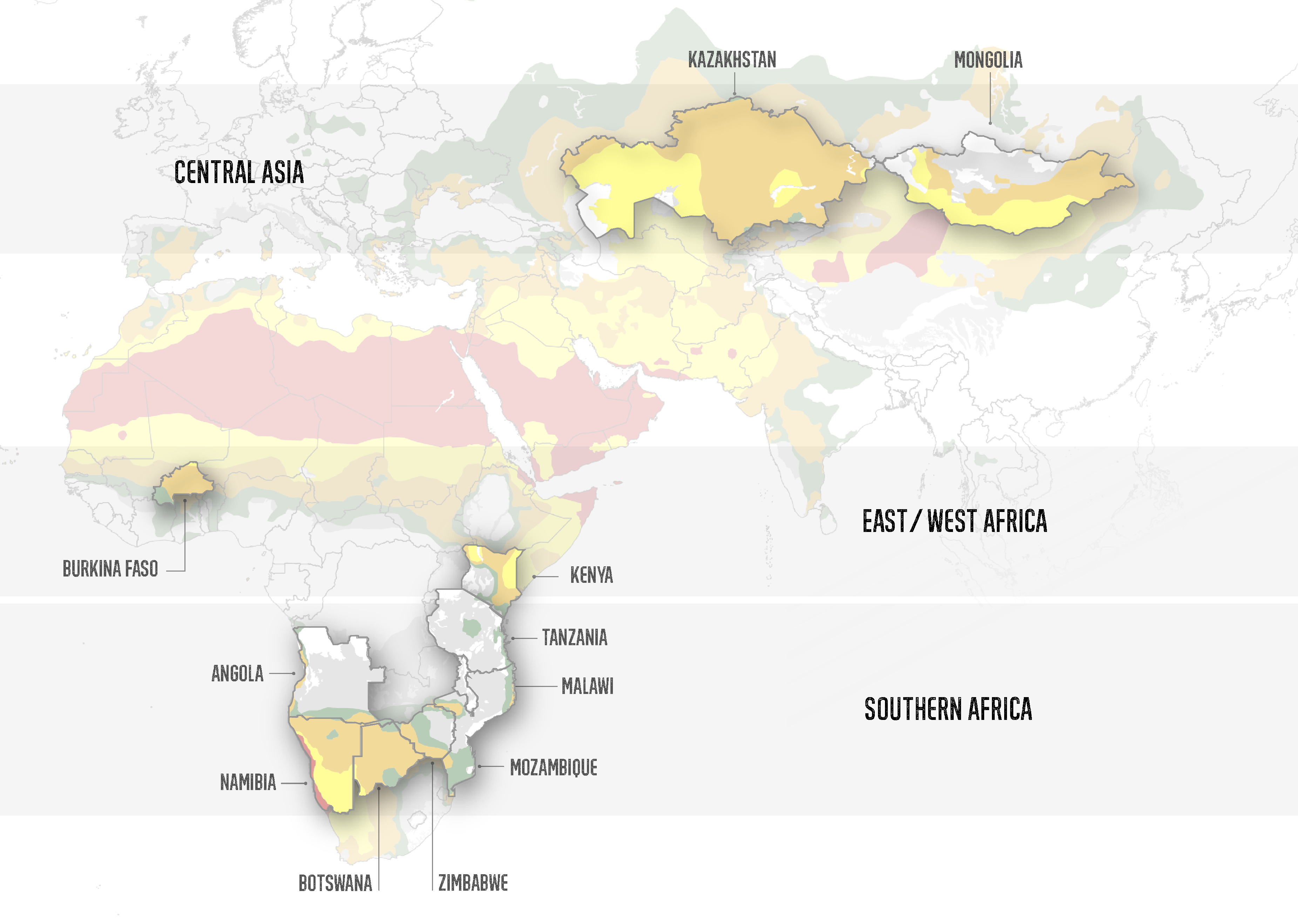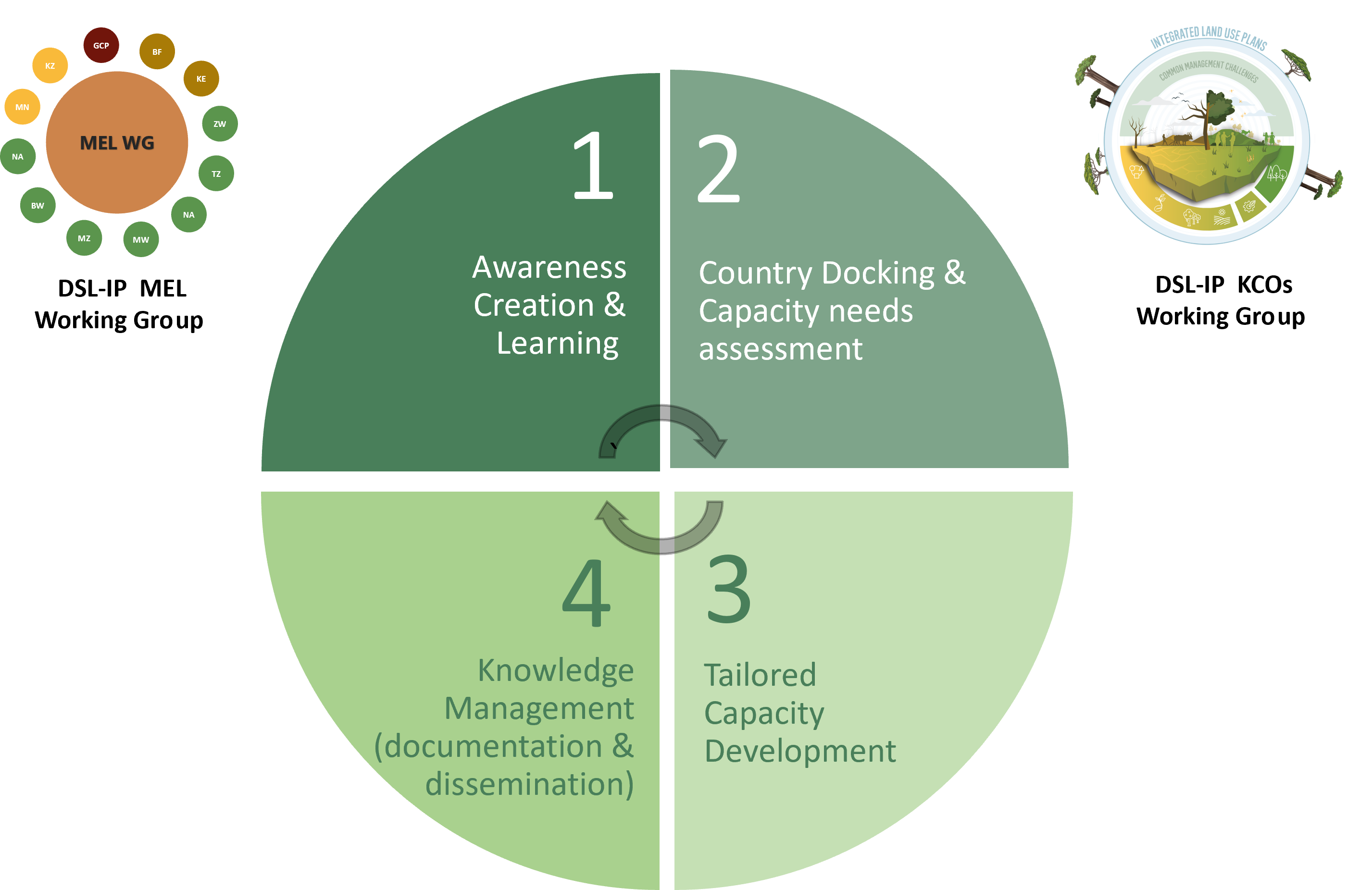
Regional Exchange Mechanisms (REMs)
REMs are expected to yield increased collaboration and coordination among DSL-IP child projects resulting in new or strengthened synergies, enhanced impacts and efficiencies, and avoidance of duplication as well as improved availability and delivery of demand-driven technical, methodological, financial and other capacity development support to child projects, leading to greater impact at country level (through a regional capacity development program). More specifically, the REMs focus on enhancing the regional dimensions of the DSL-IP child projects under the GCP to ensure multi-country collaboration and synergies, capacity development, technical support, knowledge exchange, outreach and scaling out. Each eco-region of the IP has a corresponding regional exchange mechanism: (i) the Southern African cluster, lead by FAO, operates in the Miombo-Mopane landscape; and two clusters lead by IUCN respectively operating in (ii) the Savannas of East and West Africa, and (iii) the temperate grasslands, savannas and shrublands of Central Asia. Under the GCP, these regional platforms (or mechanisms) facilitate collaboration and exchange both within and between regions as needed. Even more so, the REMs function as a directory for the child projects in accessing technical assistance and networks they may leverage for the integrated implementation of their projects.
All three REMs leverage on existing regional exchange mechanisms/platforms with a similar geographical coverage and objectives, hence the REMs complement on-going efforts and structures rather than duplicate.
REM Central Asia
REM East and West Africa
REM Southern Africa

DSL-IP Country Docking Strategy
As an impact program, the DSL-IP encompasses diverse stakeholders, including country project teams, knowledge hubs, governments, local communities, non-governmental organizations, private sector actors, partners, and international organizations. Engaging these stakeholders throughout the program’s lifecycle is crucial, as it allows for open dialogue and information sharing, which builds trust among stakeholders and enhances the program's impact. In addition, regular communication and feedback mechanisms enable stakeholders to express their views, monitor progress, and lead to the establishment of long-term partnerships and networks that extend beyond the project's duration.
The DSL-IP program is structured to amplify the impact and results of its country projects. Therefore, to ensure countries benefit from being part of the program, the DSL-IP invests heavily in country docking and alignment.

Country docking in the DSL-IP is conducted at multiple stages. From design to implementation, the DSL-IP developed materials, guides, templates and terms of reference (ToRs) to support country teams in becoming actively engaged in the program.
From awareness raising calls, to detailed capacity needs assessment, the Monitoring, Evaluation, and Learning Working Group (MEL WG), and the Knowledge, Capacity and Outreach Working Group (KCOS WG) are DSL-IP structures that create an enabling environment for such strong docking.
The One Country, One Champion Theme Approach: Addressing Common Management Challenges in Drylands
During program design stages of the DSL-IP, the subsequent review of project documents, and close consultations with relevant country teams to ensure a maximum of national ownership and buy-in, a mapping and prioritization exercise was carried out to identify core themes for the targeted 11 child projects. It focuses on core themes that can support countries in achieving LDN, with high potential for up, out and deep scaling, concrete enhancement of livelihoods, climate resilience and gender responsive approaches (link). Further, each of the identified themes provide a direct response to the identified common (region specific) management challenges that are linked to the predominant land use systems. At the end of the programme, countries will champion these identified themes and their good practices will be scaled up and out of their borders to benefit countries within the region that face similar circumstances and management challenges.
The DSL-IP project preparation design phase and subsequent (on-going) consultations with countries and partners identified common management challenges linked to the targeted land-use systems.
To address the above while supporting the Program’s theory of change, the DSL-IP presents the One country, One champion (OCOC) approach. With support of the GCP in implementation, each country is concentrating efforts in one core theme (green value chain/income generating opportunity) of common interest for the region.
REM Central Asia
Steppes and grasslands
Common Management Challenges:
- Overgrazing of pasture lands
- Low productivity of agro-sylvo-pastoral value chain
| Country | Country Core Themes | Cross-learning potential | Learn More |
| Kazakhstan |
Sustainable pasture management/grazing with trees | Mongolia, Tanzania, Kenya, Burkina Faso | Soon! |
| Mongolia | Sustainable Pasture Management | Kenya, Burkina Faso, Tanzania, Kazakhstan | Soon! |
REM East and West Africa
Rangeland, Savannas and Grasslands
Common Management Challenges:
- Unsustainable dryland resources management and land conversion that lead to land degradation
- Low productivity of agro-sylvo-pastoral value chain
| Country | Country Core Themes | Cross-learning potential | Learn More |
| Kenya | Rangeland management Drought management Eco-tourism development | Kazakhstan, Mongolia, Tanzania, Kenya, Botswana | Soon! |
| Burkina Faso | Rangeland management and grazing management Agro-sylvo-pastoral value chains Gender responsive land use planning | Kazakhstan, Mongolia, Tanzania, Kenya, Botswana | Soon! |
REM Southern Africa
Miombo/Mopane Mixed Land Use Systems
Common Management Challenges:
- Decline in agricultural productivity with increasing pressure on dryland forest
- Lack of access to integrated extension systems
- Lack of access to markets and sustainable financing
| Country | Country Core Themes | Cross-learning potential | Learn More |
| Angola | SLM/NUS - Hyacinth bean, African Yam bean, Jinguenga (tbc) | tbc | Soon! |
| Botswana | Human-Wildlife Conflict, (tbd) Sustainable Tourism (tbc) SLM/NUS: Morama Bean,Bambara, Kwengwe (tbc) | Angola | Soon! |
| Malawi | SLM/NUS: Integrated Food and Energy Systems IFES (pigeon pea and maize) | Mozambique | Soon! |
| Namibia | SLM/SFM: FSC charcoal (encroaching bush) NUS: Pearl Millet | Angola, Zimbabwe, Botswana | Soon! |
| Tanzania | SLM/SFM: Miombo Honey | Malawi, Angola, Zimbabwe | Soon! |
| Zimbabwe | SFM: Baobab/Marula (tbc) SLM/NUS - Sorghum/finger millet (tbc) | Angola, Tanzania | Soon! |
| Mozambique | Agroforestry, Protected Areas and Buffer Zones Management | Mongolia, Zimbabwe, Namibia | Soon! |
